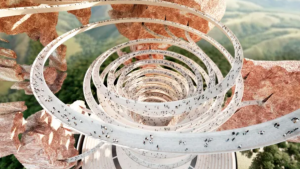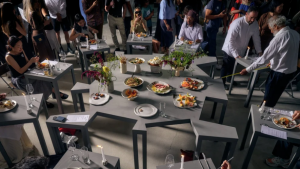Artist Gaelen Pinnock’s training in architecture has had a noticeable effect on his work. His journey from architecture to fine art has been shaped by his meticulous and structural style.
“I think I am loosening up as an artist. I started off in architecture, which is often about very precise and defined descriptions of specific objects or processes,” says Pinnock. “As I move out of architecture I am exploring more and more the less tangible, the nuanced, the blurrier. Which is a challenge for me. The architect in me wants to control. And this journey is about letting go of control. But it’s also about returning to the raw creative heart of architecture, something that is increasingly harder to find in commercial practice”
The Cape Town-based artist’s two recent sculptures, “Baucis” and “Phyllis”, form part of a new series called Invisible Cities. They are based on metropolises described in the book Invisible Cities by Italian writer Italo Calvino, an account of a fictional conversation between the Mongol emperor Kublai Khan and the Venetian explorer Marco Polo.
In the course of their discussions Polo describes a series of mythical cities, each of which bears a woman’s name. The cities are fantastical in both construction and concept. They are described in a magical, poetic manner and Pinnock’s sculptures are an attempt at distilling this in physical form.
“I am in the business of distillation. I am fascinated by the idea of taking broad, real, literal things and distilling them into some kind of essence that gives the viewer just a feeling of those things,” says Pinnock.
“One of these sculptures [Baucis] is about a city that is high in the sky on stilts and ladders, where the people don’t want to come down to the ground. They sit and scrutinise the earth through spyglasses and telescopes, contemplating with fascination their own absence… Which I thought was really beautiful – and I wanted to have that feeling of height and distance from the earth in that sculpture.”
The second sculpture, Phyllis, is based on Calvino’s description of its namesake. Here the connections between the citizens form perceivable routes in the air, and yet the buildings themselves are invisible.
Both sculptures are made with 8mm thick steel that will eventually corrode with time, taking on a reddish hue. “Baucis” comprises 11 unwelded pieces that slot together at 90-degree angles. “Phyllis” is made of eight unwelded pieces, each bolted to a base plate and bent twice to form an intricate knot of connections.
In Calvino’s book, the line between reality and fantasy is utterly blurred. The same line is becoming less defined in Pinnock’s work. As he moved away from commercial architecture, Pinnock initially used photography as an artistic tool.
“I used a camera to express what I was trying to say about the built environment. This started as pure urban documentary photography, but I found it difficult to find around me what I wanted to express artistically. So I started to construct it from scratch using collage. I found this to be very liberating.”
Pinnock’s earlier works include tremendous and strange urban forms. Citadels is a series of cylindrical island-like cities that seem to float in the air. They are made of numerous photographs of urban and industrial edifices, collaged together to form new ominous structures.
“I have a love hate relationship with the digital realm. On the one hand it offers powerful and rapid tools, yet on the other it all too often distances the maker (and viewer) from the materiality of the art. So with these sculptures it has been wonderful to make something physical again.”
Pinnock says architects work a lot with the flow between two-dimensional representation and real, three-dimensional space.
“Architecture starts in the imagination as a three-dimensional thing, which then has to be represented in numerous and complex ways on paper or screen, in order to become real. Artists spend a lot of time moving in the other direction: observing the physical world and then distilling it visually and very often two-dimensionally. I suppose the sculptures are almost a move back towards architecture.”
Gaelen Pinnock’s Invisible Cities is part of the group exhibition Loadshedding atCommune.1 Gallery in Cape Town until 16 July.









